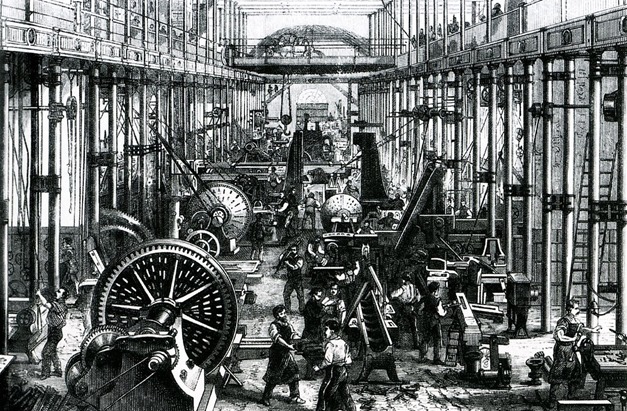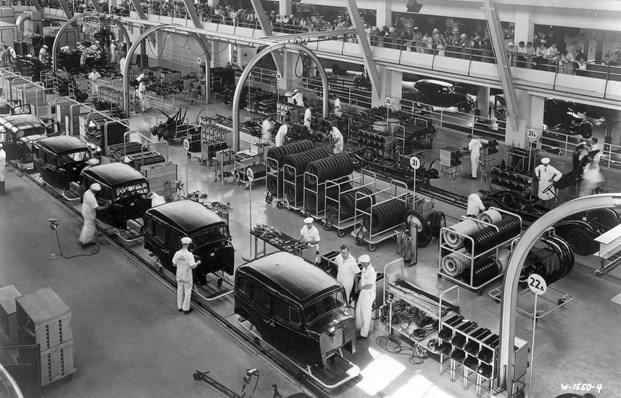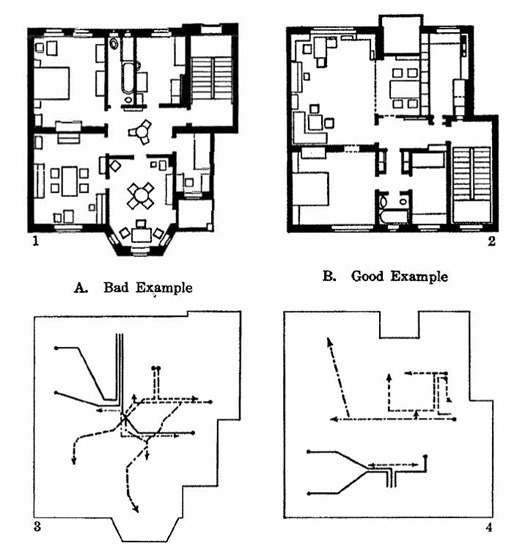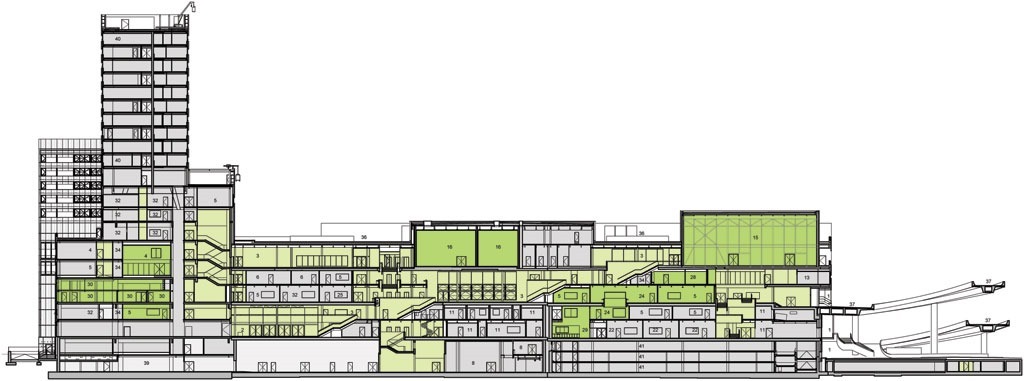At the beginning of the industrial revolution, workspaces were scattered over factory plans in no rational order. They naturally emerged around stationary large products, machines, and tool sets.
The rise of the assembly line brought a new strategy for factory space: the spatialization of the workflow, i.e. to ascribe tasks to certain spaces and to position these spaces according to the chronological order they are supposed to happen. These spaces are laid out on the basis of task duration; if a task lasts for a few seconds, the workspace around the line is very narrow, whereas if the task is lengthy, the space around the line is broader and more intricate.
The assembly line is the result of abstracting the work processes from the workers, analyzing them under a rational framework, and reintroducing them as physical constraints. The disposition of workers, supplies, and products in the ordered plan provided a quick overview of task accomplishment status to managers.
From the origin at the assembly lines, the spatialization of workflow has spread far beyond the industrial organizations. Modernist architects have taken the strategy to schools, hospitals, and even homes. Alexander Klein proposed in 1927 that the home should be designed to prevent the flow of inhabitants to cross each other. The Functional House for Frictionless Living intended to avoid family conflicts by reducing the everyday confrontation with the other.
Functionalist architecture embraced the spatialization of the workflow even when the flow was not about work. Le Corbusier went as far to say that the house was a machine for living. In line with this vision, he was one of the first to use bubble diagrams to describe functional relationships between different spaces in a new building.
The use of infographics in magazines and newspapers spread a means for seeing the spatialization of the workflow in complex buildings in a simple way. The Toni Molkerei dairy processing plant by Bosshard and Widmer is a point in case (1974).
This same plant was converted into a mixed use building in 2013 by EM2N. The program includes an art school, an university of applied sciences, a museum, event spaces, restaurants, shops, and 100 apartments. The contraction of design representation was key to the project, since the architects decided to allocate space only after making a data-rich representation with Building Information Modeling.
The building was planned to be experienced as a small city, with many possible routes and functional diversity. The coexistence of educational and cultural institutions in the same building was expected to promote the co-creation of knowledge between the inhabitants. The spatialization of the workflow that gave shape to the original building was dismantled, not without leaving its mark. Many changes had to be made to improve the flexibility in using the building.
These examples suggest that the spatialization of the workflow is in contradiction with the flexibilization of the workspace since the former aims for a perfect fit whereas the later dissociates form from function.
In my PhD research, I have been tracking how designers resolved this contradiction in the design of a medical imaging center. The medical imaging center had to support some standardized procedures for scanning patient bodies, but the managers and designers were underequipped with instruments to represent space in relation to the workflow. The workflow was visualized as a simple list of steps.
Together with my fellows at VISICO, I developed some representation instruments that could assist the spatialization of the workflow. After the project was done, I continued developing these instruments and came up with an addition to Autodesk Revit: the Walking Paths family. This tool allowed for visualizing the workflow while designing workspaces. As a proof-of-concept, I retraced the spatialization of the workflow that happened in the medical imaging center project. I did so by watching the video recordings of the managers explaining the workflow and mapping the paths into Revit.
The result of this analysis is an animation containing all the four plans produced by the designers, arranged in the chronological order. The animation shows the evolution of the design while dealing with the aforementioned contradiction.
The initial plan had a very strict spatialization of the workflow. There was almost no choice for patients (green lines) and nurses (blue lines) when they entered the flow. They had to step into a room, do what they were supposed to do and step into another room. When finished with the scanning procedure, the patient was supposed to retrace the same steps and leave. In the fourth plan, the patients and nurses could chose different paths in the corridors. There were also some additional spaces for relaxation and casual encounters.
The spatialization of the workflow was decreased in favor of the flexibilization of workspaces with the aim of promoting the co-creation of knowledge. This was no simple adjustment, but a participatory deliberation that raised some conflicts. Some people wanted to spatialize the workflow, whereas others wanted to make it more flexible. The fourth plan still preserves the contradiction, but in a lower level of tension. This is in part due to the resolution of conflicts done through the participatory design.
From this experience, I learnt that participatory design is the best way to deal with the contradiction between the spatialization of the workflow and the flexibilization of workspaces.








